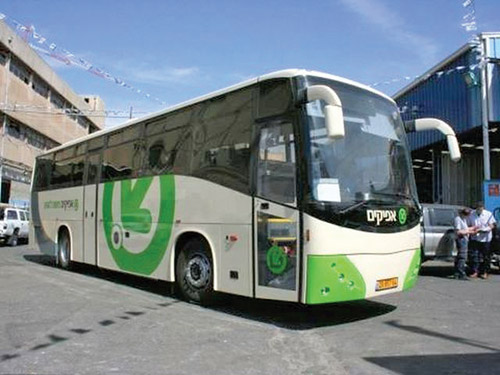


Tel Aviv—Since the reunification of the city of Jerusalem in 1967, some things have remained constant in Israel’s capital. Traffic has, is and always will be at a standstill at the merge on Ben Gurion Blvd. near the iconic “Beruchim Haba’im/Welcome” signs at the city’s entrance. A dhwarma sandwich always tasted better with a side of fumes of passing cars in the Shuk Machane Yehuda, especially if its price was haggled down by at least 10 shekalim. The Old City will always retain the charm reminiscent of its over 2000-year history, no matter what the era.
While the city of Jerusalem truly seems to follow its former ruler’s motto of “There is nothing new under the sun” (Ecclesiastes 1:9), history was made this week with the opening of Afikim Transport Ltd’s Line 485, the direct bus line from the capital city to its nearest international airport.
Residents and visitors alike may recall the logistic difficulties associated with making this trip—lacking a direct bus, those wishing to save on the approximately 200 NIS cost of a personal taxi would often resort to creative ways of making the trip in other, less convenient ways. The most direct route involved taking the infamous Egged Line 947, which, aside from stopping at every interchange, junction and gas station between its termini of Jerusalem and Haifa, has always stopped at El Al Junction in Lod. Passengers would then have to shlep their baggage across the six-lane freeway of Road 40 to the bus stop where they could catch the internal airport shuttle to the departure terminal. Upon returning to Israel, this process was reversed, except, with the 947 bus line running only every 30 to 40 minutes, weary, jetlagged passengers could almost always anticipate sitting on the side of the road with their bags for a lengthy wait, especially unpleasant in the summer heat.
The slightly pricier alternative for the more affluent traveler was reserving a space in a sherut nesher, shared ride taxis that provided door-to-door service from Jerusalem to Ben Gurion Airport for 62 NIS. Unfortunately, nesher trips came with their own unique downsides, as one could never know exactly how long his van would spend driving around Jerusalem picking up other passengers before finally departing for the airport. Hours could be spent taking the “scenic route,” unnecessarily adding to the already high stress of international travel, and drivers rarely tended to comply with even Israel’s very lax definition of “on time.”
All in all, until this new bus line began, it would take the average frugal traveler at least an hour and a half (and, oftentimes, twice that) to make the 55 km (34 mile) trek between Jerusalem and Lod.
However, with the inauguration of the direct bus service 485, Israeli airport ground transportation will be revolutionized. The bus line will run every hour, on the hour, with the exception of on Shabbat (the final departure on Fridays will be 2:00 p.m., and the first departure on Saturday evening will be 7 p.m., subject to change as Shabbat ends later).
In Jerusalem, the line will begin on Derech Rupin, opposite the Prime Minister’s Office in Giv’at Ram, followed by two stops on Kaplan St., one on Zusman St. across the street from the extensive parking garage at Cinema City and a final stop on the corner of Yafo and Moriya St., adjacent to the Central Bus Station. Afterwards, the route will exit Jerusalem and make pickup stops at Hemed and Shoresh Interchanges on the side of Route 1, and then proceed directly to Ben Gurion Airport, dropping off passengers at the departures halls at Terminal 1 (open only for domestic flights until the end of May) and Terminal 3 (for all international flights).
For returning passengers, the 485 line will depart from the arrivals level of Ben Gurion’s Terminal 3 (exit the terminal, turn right and proceed to the end of the pickup area, then cross the road to the island platform) on the hour, and, after picking up outside of the arrivals hall of Terminal 1, will drop off at Shoresh and Hemed Interchanges on Route 1, then, upon entering Jerusalem, at Binyanei Ha’uma, followed by the stops listed above, ultimately terminating at the intersection of Kaplan St. and Muze’onim Blvd.
The cost of the bus will be 16 NIS in each direction, with 33 percent and 50 percent discounts available to students and senior citizens, respectively (Israeli ID usually required). As of now, fares can be paid on the bus with cash or stored value (erech tzavur) balance on a Rav-Kav farecard, but Afikim plans on rolling out a system for prepaying and reserving seats on the 485 via their website in the near future.
While some parts of living in Jerusalem will never change, residents of Israel’s capital are certainly hoping that, King Solomon’s laconic but accurate perspective on innovation aside, this latest revolution will make their occasional trips abroad even easier. After all, there is a “time and place, for every desire under the heaven” (3:1), and hour three into a sherut nesher ride and 25 minutes of sitting in the rain on the side of the highway in Lod were certainly never meant to be part of the stress of traveling, or make lengthy trips even longer. Jerusalemites and visitors alike can finally enjoy convenient access to their international flights.
For more information about the 485 bus line between Jerusalem and Tel Aviv-Ben Gurion International Airport, please visit http://www.afikim-t.co.il/?busline=485 (Hebrew) or dial *6686 from any Israeli mobile phone (press “3” then “5’”—most representatives speak English).
By Tzvi Silver/JLNJ Israel









